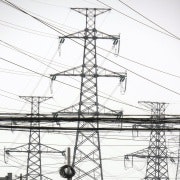Emissions continue to rise, demand decline slows
The CEDEX Electricity Update shows that the month by month increase in annualised emissions from NEM electricity generation, which started in July, continued unabated in November (Figure 5). Annual emissions in the year to November 2014 were 3.2 Mt CO2‐e higher than in the year to June 2014, an increase of 2.2% in five months.
If this rate of increase were continue for a year, NEM electricity generation emissions would, by themselves, increase Australia's total emissions by 1.4%. Since demand has continued to fall over the past five months, average emissions intensity has increased slightly more than total emissions – 2.4%.
The same supply side factors were at work in November as in each of the previous four months (Figure 6). Annualised hydro generation continued its precipitate fall and wind generation scarcely changed over the month, leaving space for increases in both gas and brown coal generation. Annual hydro generation for the year to November was at its lowest level since the year to August 2012, just after the carbon price came into effect. Hydro Tasmania, Australia's largest source of hydro generation, kept output higher for longer than the other major hydro generators – right up until early August this year – and has since cut back harder. Its generation for the month in November was its lowest monthly output since early 2010. Since annualised wind generation showed almost no change in November, it was a particularly bad month for total renewable generation, which was at its lowest annualised level since March 2013.
Annualised gas generation was down in NSW and SA, slightly up in Victoria, and strongly up in Queensland. The low short term wholesale gas prices available in Queensland are clearly the reason. The average spot price in the Brisbane gas market hub, as reported by the Australian Energy Regulator, was just $0.48 per GJ, compared with an average of $4.55 per GJ for the 2013‐14 financial year, and even higher levels in July and August this year. There have also been spot price falls, though much less dramatic, in the Sydney, Victoria and Adelaide markets. As previously explained, these low prices are a strictly short term phenomenon and will end as soon as the LNG plants at Gladstone come on stream, which is expected to be early in 2015.
The change in SA gas generation is in some ways more interesting, as it indicates a structural shift in the state electricity market. Because of its very poor endowment with local coal, SA has been much more heavily dependent on gas generation than other NEM states for over 40 years. However, the share of gas in the state's generation mix has been falling steadily and in annual terms is now at its lowest absolute level for 14 years, displaced by wind, rooftop solar, and increased net imports of brown coal electricity from Victoria. Heavy dependence on gas generation formerly meant that wholesale electricity prices were significantly higher than in other NEM states. This difference has been steadily eroded over the past few years, to the obvious benefit of electricity consumers in the state.
Data for November indicate a slowdown, at least for the month, in the rate at which demand is falling, with a minuscule increase in annualised total NEM demand for the month (Figure 7). In fact, demand increased slightly in every NEM state except Victoria, where, as discussed in previous Updates, the effect of the closure of the Point Henry aluminium smelter is steadily working its way through the annualised demand totals recorded each month.
Total NEM demand for electricity is now 8.1% lower than its peak, in late 2010. Possibly more interestingly, there was a slight fall in demand in WA for the year to October. This is consistent with economic data, which indicate a slowdown in economic activity in the state, but it would be premature to suggest that WA may be starting to follow the demand trend seen in the NEM, as there have been several previous one month slowdowns in demand growth, each followed by renewed growth.
This is the latest Carbon Emissions Index report on Australia's energy emissions from pitt&sherry. Data analysis, text and graphs: Hugh Saddler, Hannah Meade and Mark Johnston.


















